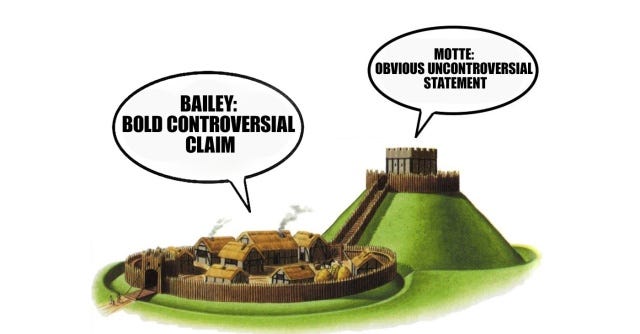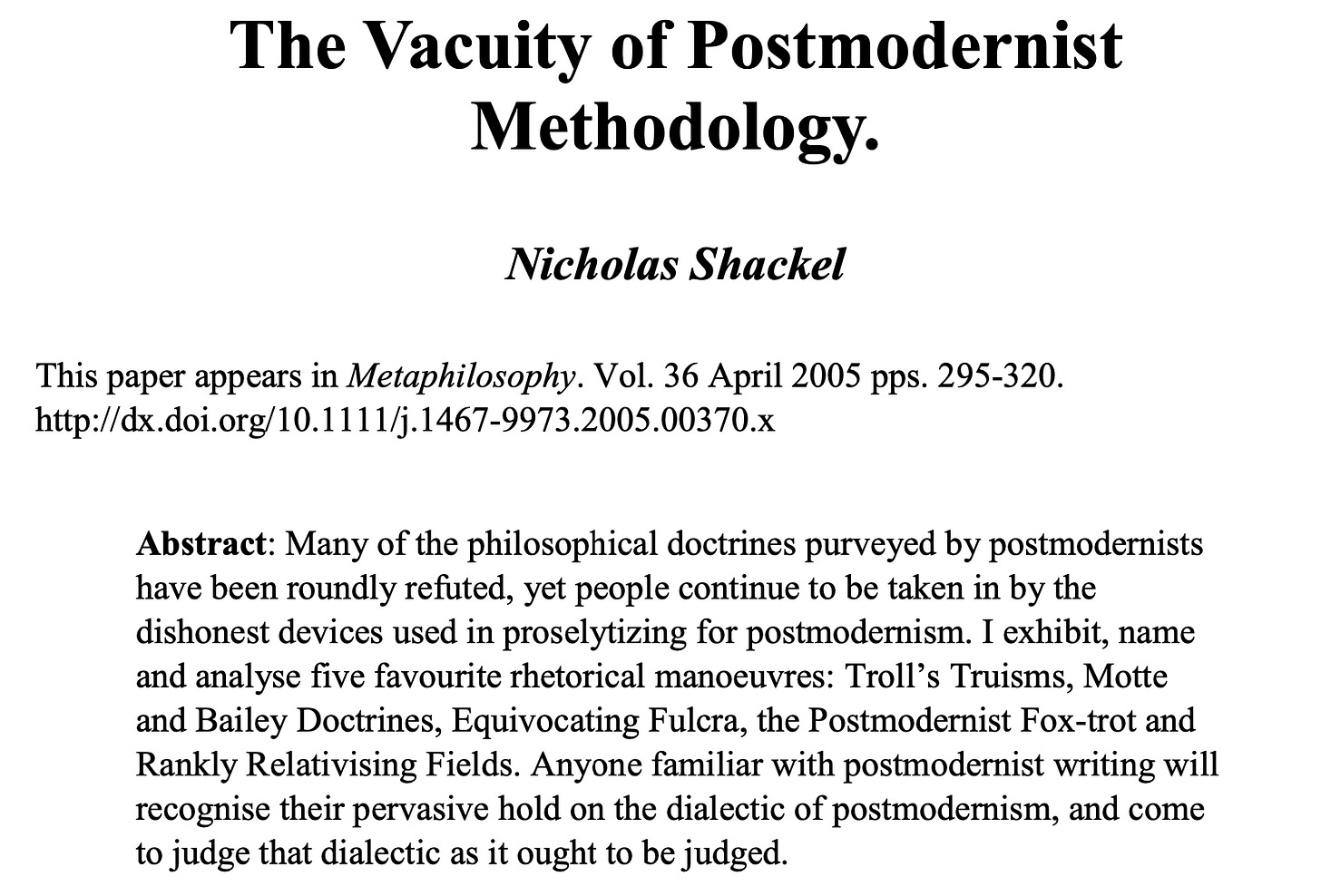Arguer: Churches teach myths, so children under 18 shouldn’t be allowed to attend church (Bailey).
Respondent: Actually, denying parents the right to decide whether and where they worship with their children may be considered as against religious freedom.
Arguer: I just believe in defending the intellectual rights of children! (Motte).
(this example is for illustration purpose only, it does not represent a personal view on the topic)
Did you catch what happened here?
The arguer pushed provocative forward a position on religion and children. However, when confronted to explain better and acknowledge the inherent limitations of such position; the arguer does something different, changes the meaning of what was initially said and turns the initial position into one that is impossible to disagree with.
The “Motte and Bailey” fallacy is a rhetorical strategy that begins with someone presenting a controversial and hard to defend point (the “Bailey”) and when challenged to explain, the controversy gets replaced by a more defensible position (the “Motte”), as if it were equivalent to the original one.
In very simple terms, using the Motte and Bailey means: saying something very provocative, and, when confronted to debate it, retreating to an obviously true claim that is non debatable, pretending that is what was meant all along.
Picture it: The Bailey is pushed forward but when confronted, the position is retreated to the Motte where the arguer can hide the initial intention.
The strategy typically hides behind the use of “just”: “I JUST mean”, “it’s JUST this”.
When the respondent feels compelled to ask “What do you mean by…(the provocative statement)?”, the arguer evades the dialogue by saying “I just mean… (an obvious truth)”, which can even be followed by “don’t you agree with that (the obvious truth)?”, forcing you to admit “yes, of course I agree with that”, as if you were in agreement then with the original provocative position.
It is irrelevant if I agree with the Motte because it is not the Motte what started the debate, it is the Bailey!!
This type of argumentative strategy feels like a trap (it is a trap) because 1. you can get confused about what the real point under debate is, and 2. you can’t disagree with the new point made. If you are not aware, you can be easily manipulated to think you are in agreement with the Bailey simply because you agree with the Motte.
Origins of “Motte and Bailey”
The name to this logical fallacy was given by philosophy Professor Nicholas Shackel in his 2005 paper, The Vacuity of Postmodern Methodology. (linked to the .pdf)
from the original text:
“A Motte and Bailey castle is a medieval system of defence in which a stone tower on a mound (the Motte) is surrounded by an area of land (the Bailey) which in turn is encompassed by some sort of a barrier such as a ditch. Being dark and dank, the Motte is not a habitation of choice. The only reason for its existence is the desirability of the Bailey, which the combination of the Motte and ditch makes relatively easy to retain despite attack by marauders. When only lightly pressed, the ditch makes small numbers of attackers easy to defeat as they struggle across it: when heavily pressed the ditch is not defensible and so neither is the Bailey. Rather one retreats to the insalubrious but defensible, perhaps impregnable, Motte. Eventually the marauders give up, when one is well placed to reoccupy desirable land.
(…) the Bailey, represents a philosophical doctrine or position with similar properties: desirable to its proponent but only lightly defensible. The Motte is the defensible but undesired position to which one retreats when hard pressed.”
“The Motte and Bailey fallacy is an argument substitute, it’s a play” (…) that ultimately “allows the arguer to claim that he’s never actually been refuted,” Professor Christopher Anadale (2018 lecture posted on YouTube)
Why does this matter?
The Motte and Bailey fallacy can be used to manipulate people, and deceive them into accepting a position that they would not otherwise accept.
The Motte and Bailey strategy can be used to avoid engaging in honest debate and to shut down opposing viewpoints in a deceptive manner. It’s a rhetorical maneuver that often obscures sound reasoning.

The "Motte" is the ideal high ground for the deceiver to wage war. Don’t let them escape the “Bailey”.
To avoid falling prey to the Motte and Bailey fallacy, it is important to be aware of it and to recognize when it is being used. One of the most relevant insights is to always ask for evidence to support a position, and to pay attention of arguments that rely on emotional appeals or vague generalizations.
Real-life examples of the Motte and Bailey fallacy can be frequently found in political discourse and public debates, with most big statements made to catch people’s attention.
For instance, the Motte and Bailey fallacy is often use in discussions of controversial issues, such as climate change. Someone against the idea that climate change is happening might present extreme arguments against its existence (the Bailey position) but when confronted to present the evidence to better explain the perspective, retreats to a more defensible position, like for example that they are simply calling for more research on the topic before taking specific actions (the Motte position).
The implications of the Motte and Bailey fallacy can be significant. In political or public discourse, it can lead to a lack of accountability and transparency, as policy makers are able to avoid addressing specific criticisms of their policies, or delay action on pressing issues by derailing efforts to address the problem.
The Motte is that campaign slogan everyone agrees with. The Bailey is the controversial program underneath that not everyone can support.
The Bailey is the real agenda behind the misleading Motte slogan.
The Motte and Bailey fallacy in the context of teams and organizations
In team’s settings, the Motte and Bailey fallacy can lead to a lack of trust and collaboration, as team members may feel that their concerns or criticisms are not being taken seriously. This can also lead to a lack of diversity of thought and a failure to consider alternative perspectives, which can ultimately result in poor decision-making.
Let's say there is a team leader who wants to implement a new process that some team members are skeptical about. The team leader presents the new process as a "game-changer" that will revolutionize the team's productivity and efficiency (the Bailey position). When some team members express concerns about the potential downsides of the new process, such as increased workload or decreased quality, and start asking specific questions to better understand the pro and cons, the team leader retreats to the Motte position by saying, "I'm just trying to move the ball here, we need to make incremental improvements. We can always adjust the process if it doesn't work out."
In this example, the team leader is using the Motte and Bailey fallacy to avoid addressing specific concerns of the new proposed process while still promoting it as just needed improvement, which nobody can disagree with. But this can lead to lack of trust among team members, as they may feel that the rationale behind proposals is not clear and their input is not being valued or they are not taken seriously.
Conclusion
Once you understand the Motte and Bailey fallacy, you will see it frequently as a dishonest tool to avoid genuine debate, and any proposed argument with contradictory definitions of the issue at hand, is not an argument worth having. You have to see it for what it is, and consistently work to separate the Bailey from the Motte.
Challenge the Bailey relentlessly or you will get stuck in someone else’s Motte.
P.S. Before I go, here you have “The Treat,” where I share some of the music that kept me company while writing … Enjoy as you bid farewell to this post
Lead yourself, Learn to live. Lead others, Learn to Build.
P.S. If you enjoyed reading this post consider subscribing to the newsletter, joining the community and sharing your thoughts.








